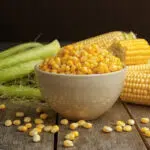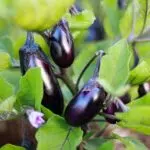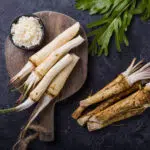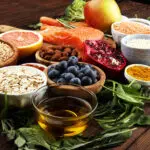National Horseradish Month is celebrated every year in July and we couldn’t be happier. It’s time we start talking about important stuff like horseradish. Not to get political, but horseradish is insanely good. If you haven’t had horseradish already, you’re in for a real treat. It’s a heavily underrated root vegetable that looks similar to ginger and whose taste can be best described as hot, spicy, peppery, and a little pungent.
Sounds…delicious? We know what you’re thinking. But adding a little bit of it to your dish can truly elevate it and introduce your mouth to a whole new world of flavors! Horseradish is an easy way to beef up any dish and tantalize your taste buds.
History of National Horseradish Month
Horseradish has a long history and has been used across cultures for its many purposes. It is a root vegetable, cultivated and used around the world as a spice and a condiment. The species is likely native to southeastern Europe and western Asia and has been grown since ancient times. Even Roman senator Cato the Elder discussed the plant in his treatises on agriculture, while a mural in Pompeii depicts the plant. That’s how you know Horseradish is old.
This 3,000-year-old plant has been used for everything — as an aphrodisiac, a treatment for rheumatism, a bitter herb for Passover seders, and a flavorful companion to beef, chicken, and seafood. Even the Egyptians knew about horseradish as early as 1500 B.C. Early Greeks used to rub it on the lower back of patients to relieve pain. Jewish people still use it during Passover seders as a bitter herb.
Both its roots and leaves were used in the form of traditional medicine during the Middle Ages. The root was used as a condiment with meats in places like Germany, Scandinavia, and Britain. It was only introduced to North America during European colonization but quickly became popular there. Both George Washington and Thomas Jefferson mention horseradish in garden accounts. It’s such a versatile food that the Native Americans used it to stimulate glands, counter scurvy, and as a diaphoretic treatment for the common cold. Some cultures even believe that horseradish is the cure to everything!
According to legend, Delphi, the oracle, told Apollo, “The radish is worth its weight in lead, the beet its weight in silver, the horseradish its weight in gold.” Now that’s high praise! Horseradish comes recommended by the High Priestess of the Temple of Apollo herself, the woman who knew everything. How do you say no to Delphi?
National Horseradish Month timeline
English peasantry cook beef and seafood with horseradish while the gentry takes little notice of it as a condiment.
Eating horseradish becomes popular in Central Europe, later gaining popularity in Scandinavia and England.
The English gentry begin consuming the root with beef and oysters and start growing it at inns and coach stations for tired travelers.
Commercial cultivation in America begins as immigrants start horseradish farms in the Midwest.
National Horseradish Month FAQs
What does horseradish go well with?
It pairs well with the flavors of potatoes, beets, peas, broccoli, and leeks. Another popular way to use this herb is to spice up your roast beef sandwich with it.
Why does horseradish burn your sinus?
When horseradish is chopped or chewed, it releases a compound called allyl isothiocyanate. As we eat, this chemical’s vapor travels through the back of the mouth and up into the nasal cavity. This triggers a nerve response in the nose and sinuses, leading to a nose-tingling burn.
Are there any negatives to eating horseradish?
Horseradish is safe in normal food and medicinal amounts, but it contains mustard oil which is extremely irritating to the lining of the mouth, throat, nose, digestive system, and urinary tract. The herb can cause side effects including an upset stomach, bloody vomiting, and diarrhea. It could also slow down the activity of the thyroid gland.
National Horseradish Month Activities
Look up new recipes
Look up some recipes that involve horseradish and see how you can incorporate it into your food. While you’re doing this research, you can also search for other great foods that you haven’t tried before and experiment.
Cook with horseradish
It’s time to cook some delicious food now that you’ve looked up the recipes. Add some horseradish to your favorite meat dish and watch it transform into some of the best-tasting food you’ve ever had.
Treat your friends
Call over your friends and family and have a wholesome dinner party with them. Dazzle them with your cooking skills and introduce them to the wonderful condiment that is horseradish.
5 Facts About Horseradish That Will Blow Your Mind
A replacement for wasabi
Outside Japan, the condiment wasabi is now increasingly being made with horseradish because the wasabi plant is rare.
It has biomedical uses
The enzyme horseradish peroxidase (H.R.P.), found in the plant, is heavily used in molecular biology and biochemistry.
It is poisonous to horses
It’s ironic to note that horseradish is poisonous to our equine friends and they must never consume it.
It becomes bitter when exposed to air
On being exposed to air or heat, horseradish loses its pungency, becomes darker in color, and develops a bitter flavor.
Horseradish got its name by mistake
The German word for horseradish is ‘meerrettich’ which means sea radish, but the English mistook the name and pronounced it as ‘mareradish’ and the name eventually changed to ‘horseradish.’
Why We Love National Horseradish Month
It has a unique taste
Horseradish has a truly unique taste that’s unlike any other. It adds a little pizzazz to any dish it’s part of and elevates it. It’s a staple condiment in many parts of Europe and is slowly becoming popular in other parts of the world as well.
It’s very healthy
Different cultures have been using horseradish as a medicinal herb for centuries. It helps stimulate blood flow to the surface of the skin and beneath it, thereby alleviating pain. You can even treat the symptoms of illnesses like gout, arthritis, and chilblains by applying horseradish over the affected areas. It also relieves swollen joints and muscles.
It’s very versatile
Horseradish is a truly versatile plant as you can use it in almost any cuisine and in different ways. You can season a steak with it, sprinkle some with your salad, make soup out of it, use it as a dip, and even make dressing or sauce out of it.
National Horseradish Month dates
| Year | Date | Day |
|---|---|---|
| 2025 | July 1 | Tuesday |
| 2026 | July 1 | Wednesday |
| 2027 | July 1 | Thursday |
| 2028 | July 1 | Saturday |
| 2029 | July 1 | Sunday |





















































































